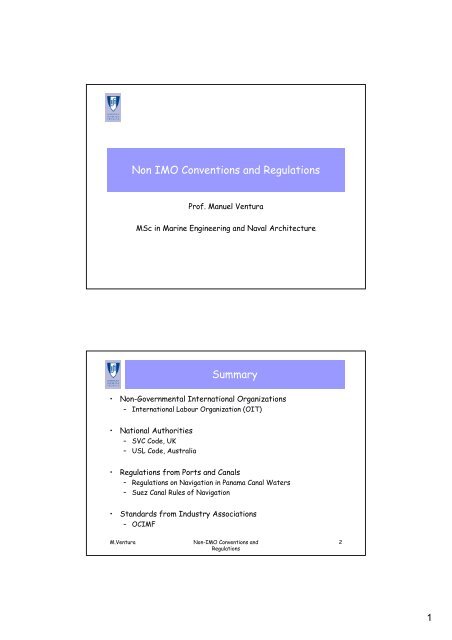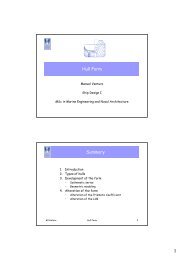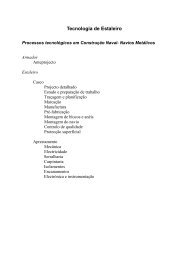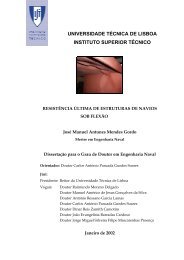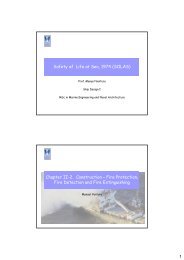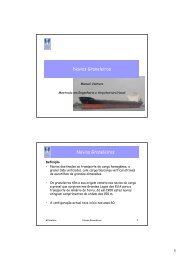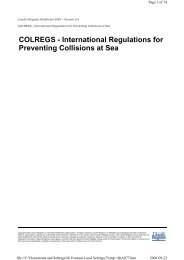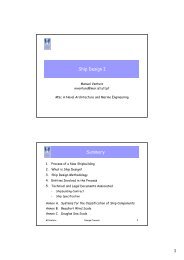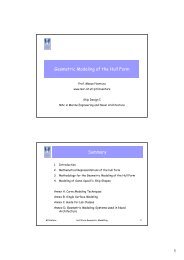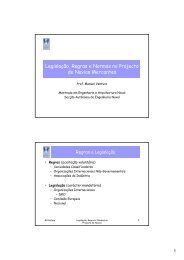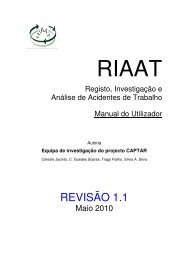Non IMO Conventions and Regulations Summary
Non IMO Conventions and Regulations Summary
Non IMO Conventions and Regulations Summary
Create successful ePaper yourself
Turn your PDF publications into a flip-book with our unique Google optimized e-Paper software.
<strong>Non</strong>-Governmental InternationalOrganizationsManuel VenturaInternational Labour Organization (ILO)2
Consolidated Marine Convention (2006)ILOConsolidated Marine Convention (2006)• Integrates all the dispositions scattered in previous conventions,namely the following:– Accommodation of Crews Convention, 1946 (No.75)– Accommodation of Crews Convention (Revised), 1949 (No.92)– Accommodation of Crews Convention (Supplementary Provisions),1970 (No.133)– Merchant Shipping (Minimum St<strong>and</strong>ards) Convention, 1976(No.147)– Protocol of 1996 to the Merchant Shipping (Minimum St<strong>and</strong>ards)Convention, 1976 (No.147)– Health Protection <strong>and</strong> Medical Care (Seafarers) Convention, 1987(No.164)M.Ventura<strong>Non</strong>-<strong>IMO</strong> <strong>Conventions</strong> <strong>and</strong><strong>Regulations</strong>105
Organization of the Convention• The Convention comprises three different but related parts:– Articles– <strong>Regulations</strong>– Code• The Articles <strong>and</strong> <strong>Regulations</strong> set out the core rights <strong>and</strong>principles <strong>and</strong> the basic obligations of Members ratifying theConvention.• The Code contains the details for the implementation of the<strong>Regulations</strong>. It comprises:– Part A (m<strong>and</strong>atory St<strong>and</strong>ards)– Part B (non-m<strong>and</strong>atory Guidelines).M.Ventura<strong>Non</strong>-<strong>IMO</strong> <strong>Conventions</strong> <strong>and</strong><strong>Regulations</strong>11<strong>Regulations</strong> <strong>and</strong> the CodeAre organized under five Titles:• Title 1: Minimum requirements for seafarers to work on a ship• Title 2: Conditions of employment• Title 3: Accommodation, recreational facilities, food <strong>and</strong>catering• Title 4: Health protection, medical care, welfare <strong>and</strong> socialsecurity protection• Title 5: Compliance <strong>and</strong> enforcementM.Ventura<strong>Non</strong>-<strong>IMO</strong> <strong>Conventions</strong> <strong>and</strong><strong>Regulations</strong>126
Types of Crew Members• Officer - means a person other than a master ranked as anofficer by national laws or regulations, or, in the absence ofany relevant laws or regulations, by collective agreement orcustom• Rating - means a member of the crew other than an officer• Petty Officer - means a rating serving in a supervisoryposition or position of special responsibility who is classed aspetty officer by national laws or regulations, or, in theabsence of any relevant laws or regulations, by collectiveagreement or customM.Ventura<strong>Non</strong>-<strong>IMO</strong> <strong>Conventions</strong> <strong>and</strong><strong>Regulations</strong>13A3.1 - Accommodation <strong>and</strong> RecreationalFacilities• The competent authorities shall give special attention to theimplementation of the following points of this Convention– Sizes of the cabins <strong>and</strong> other accommodation spaces– Heating <strong>and</strong> ventilation– Noise, vibrations <strong>and</strong> other environmental factors– Sanitary facilities– Illumination– HospitalM.Ventura<strong>Non</strong>-<strong>IMO</strong> <strong>Conventions</strong> <strong>and</strong><strong>Regulations</strong>147
General Requirements For Accommodation• Free height h ≥ 203 cm• In ships other than passenger ships, sleeping rooms shall besituated above the load line amidships or aft• In exceptional cases, sleeping rooms may be located in thefore part of the ship, but in no case forward of the collisionbulkhead• There shall be no direct openings into sleeping rooms fromcargo <strong>and</strong> machinery spaces or from galleys, storerooms,drying rooms or communal sanitary areasM.Ventura<strong>Non</strong>-<strong>IMO</strong> <strong>Conventions</strong> <strong>and</strong><strong>Regulations</strong>15Requirements For Ventilation And Heating• Sleeping rooms <strong>and</strong> mess rooms shall be adequately ventilated• Ships, shall be equipped with air conditioning for seafareraccommodation, for any separate radio room <strong>and</strong> for anycentralized machinery control room• All sanitary spaces shall have ventilation to the open air,independently of any other part of the accommodation• Adequate heat through an appropriate heating system shall beprovided, except in ships exclusively on voyages in tropicalclimates.M.Ventura<strong>Non</strong>-<strong>IMO</strong> <strong>Conventions</strong> <strong>and</strong><strong>Regulations</strong>168
Requirements For Lighting• Sleeping rooms <strong>and</strong> mess rooms shall be lit by natural light<strong>and</strong> provided with adequate artificial light.• Subject to such special arrangements as may be permitted inpassenger shipsM.Ventura<strong>Non</strong>-<strong>IMO</strong> <strong>Conventions</strong> <strong>and</strong><strong>Regulations</strong>17Sleeping Rooms for Seafarers (1)• In ships other than passenger ships, an individual sleepingroom shall be provided for each seafarer• In the case of ships of GT < 3,000 or special purpose ships,exemptions may be granted• Separate sleeping rooms shall be provided for men <strong>and</strong> forwomen• Sleeping rooms shall be of adequate size <strong>and</strong> properlyequipped so as to ensure reasonable comfort <strong>and</strong> to facilitatetidiness• A separate berth for each seafarer shall in all circumstancesbe provided• The inside dimensions of a berth >= 198 x 80 cmM.Ventura<strong>Non</strong>-<strong>IMO</strong> <strong>Conventions</strong> <strong>and</strong><strong>Regulations</strong>189
Sleeping Rooms for Seafarers (2)• In single berth seafarers’ sleeping rooms the floor area shallnot be less than:– 4.5 m2 (ships GT < 3,000)– 5.5 m2 (ships 3,000 < GT < 10,000)– 7.0 m2 (ships GT > 10,000)• In ships GT < 3,000 other than passenger ships <strong>and</strong> specialpurpose ships, sleeping rooms may be occupied by a maximumof 2 seafarers, but the floor area ≥ 7 m2M.Ventura<strong>Non</strong>-<strong>IMO</strong> <strong>Conventions</strong> <strong>and</strong><strong>Regulations</strong>19Sleeping Rooms for Seafarers (3)• On passenger ships <strong>and</strong> special purpose ships the floor areaof sleeping rooms for seafarers (not ships’ officers) shall notbe less than:– 7.5 m2 (rooms for 2 persons)– 11.5 m2 (rooms for 3 persons)– 14.5 m2 (rooms for 4 persons)• On special purpose ships sleeping rooms may accommodatemore than 4 persons, but the floor area shall ≥ 3.6m2/personM.Ventura<strong>Non</strong>-<strong>IMO</strong> <strong>Conventions</strong> <strong>and</strong><strong>Regulations</strong>2010
Sleeping Rooms for Officers (1)• On ships other than passenger ships <strong>and</strong> special purpose ships,sleeping rooms for ships’ officers, where no private sittingroom or day room is provided, the floor area per person shallnot be less than:– 7.5 m2 (ships GT < 3,000)– 8.5 m2 (ships 3,000 < GT < 10,000)– 10.0 m2 (ships GT > 10,000)M.Ventura<strong>Non</strong>-<strong>IMO</strong> <strong>Conventions</strong> <strong>and</strong><strong>Regulations</strong>21Sleeping Rooms for Officers (2)• On passenger ships <strong>and</strong> special purpose ships the floor areaof sleeping rooms for ships’ officers where no private sittingroom or day room is provided, the floor area per person shallnot be less than– 7.5 m2 for junior officers– 8.5 m2 for senior officers• Junior officers are understood to be at the operational level,<strong>and</strong> senior officers at the management levelM.Ventura<strong>Non</strong>-<strong>IMO</strong> <strong>Conventions</strong> <strong>and</strong><strong>Regulations</strong>2211
Sleeping Rooms for Officers (3)• The master, the chief engineer <strong>and</strong> the chief navigatingofficer shall have, in addition to their sleeping rooms, anadjoining sitting room, day room or equivalent additionalspace (ships of GT < 3,000 may be exempted)• For each occupant, the furniture shall include:– a clothes locker (min. 475 litres)– a drawer or equivalent space (min. 56 litres)– if the drawer is incorporated in the clothes locker then thecombined minimum volume of the clothes locker shall be 500litres; it shall be fitted with a shelf <strong>and</strong> be able to be locked bythe occupant so as to ensure privacy;• Each sleeping room shall be provided with a table or desk,which may be of the fixed, drop-leaf or slide-out type, <strong>and</strong>with seating accommodation as necessary.M.Ventura<strong>Non</strong>-<strong>IMO</strong> <strong>Conventions</strong> <strong>and</strong><strong>Regulations</strong>23Requirements for Mess Rooms• Mess rooms shall be located– apart from the sleeping rooms– as close as practicable to the galley• Ships of GT < 3,000 may be exempted by the competentauthority• Mess rooms shall be– of adequate size <strong>and</strong> comfort– properly furnished <strong>and</strong> equipped taking account of the number ofseafarers likely to use them at any one time– separate or common room facilities as appropriate.M.Ventura<strong>Non</strong>-<strong>IMO</strong> <strong>Conventions</strong> <strong>and</strong><strong>Regulations</strong>2412
Mess Rooms (1)• Mess room facilities may be either common or separate.• The decision in this respect should be taken afterconsultation with seafarers’ <strong>and</strong> shipowners’ representatives<strong>and</strong> subject to the approval of the competent authority.• Where separate mess room facilities are to be provided toseafarers, then separate mess rooms should be provided for:– Master <strong>and</strong> officers– Petty officers <strong>and</strong> other seafarers.M.Ventura<strong>Non</strong>-<strong>IMO</strong> <strong>Conventions</strong> <strong>and</strong><strong>Regulations</strong>25Mess Rooms (2)• On ships other than passenger ships, the floor area of messrooms for seafarers should be >= 1.5 m2/person of theplanned seating capacity.• In all ships, mess rooms should be equipped with tables <strong>and</strong>appropriate seats, fixed or movable, sufficient toaccommodate the greatest number of seafarers likely to usethem at any one time.• There should be available at all times when seafarers are onboard:– a refrigerator– facilities for hot beverages– cool water facilities.M.Ventura<strong>Non</strong>-<strong>IMO</strong> <strong>Conventions</strong> <strong>and</strong><strong>Regulations</strong>2613
Mess Rooms (3)• Where available pantries are not accessible to mess rooms,adequate lockers for mess utensils <strong>and</strong> proper facilities forwashing utensils should be provided.• The tops of tables <strong>and</strong> seats should be of damp-resistantmaterial.M.Ventura<strong>Non</strong>-<strong>IMO</strong> <strong>Conventions</strong> <strong>and</strong><strong>Regulations</strong>27Sanitary Facilities (1)• All seafarers shall have convenient access on the ship tosanitary facilities meeting minimum st<strong>and</strong>ards of health <strong>and</strong>hygiene <strong>and</strong> reasonable st<strong>and</strong>ards of comfort• Separate sanitary facilities will be provided for men <strong>and</strong> forwomen• There shall be sanitary facilities within easy access of thenavigating bridge <strong>and</strong> the machinery space or near the engineroom control centre (ships GT < 3,000 may be exempted)• In all ships a minimum of 1 toilet, 1 wash basin <strong>and</strong> 1 tub orshower or both for every 6 persons or less, who do not havepersonal facilities, shall be provided at a convenient locationM.Ventura<strong>Non</strong>-<strong>IMO</strong> <strong>Conventions</strong> <strong>and</strong><strong>Regulations</strong>2814
Sanitary Facilities (2)• With the exception of passenger ships, each sleeping roomshall be provided with a washbasin having hot <strong>and</strong> cold runningfresh water, except where such a washbasin is situated in theprivate bathroom provided• In passenger ships normally engaged on voyages of not morethan 4 hours’ duration, consideration may be given by thecompetent authority to special arrangements or to a reductionin the number of facilities required• Hot <strong>and</strong> cold running fresh water shall be available in all washplaces.M.Ventura<strong>Non</strong>-<strong>IMO</strong> <strong>Conventions</strong> <strong>and</strong><strong>Regulations</strong>29Hospital Accommodation• Ships carrying 15 or more seafarers <strong>and</strong> engaged in a voyageof more than 3 days’ duration shall provide separate hospitalaccommodation to be used exclusively for medical purposes• The competent authority may relax this requirement for shipengaged in coastal trade• The accommodation will, in all weathers, be easy of access,provide comfortable housing for the occupants <strong>and</strong> beconducive to their receiving prompt <strong>and</strong> proper attention.M.Ventura<strong>Non</strong>-<strong>IMO</strong> <strong>Conventions</strong> <strong>and</strong><strong>Regulations</strong>3015
Seafarer’s Hours of Work <strong>and</strong> Rest• Applies to all ships engaged in commercial marine operations<strong>and</strong> that are registered in territory of a Member in which theConvention has entry into force• The working hours shall not exceed– 14 hours, in any period of 24 hours– 72 hours, in any period of 7 days• The rest hours shall not be less than– 10 hours, in any period of 24 hours– 77 hours, in any period of 7 days• The rest hours shall not be divided in more than 2 periods, 1of each ≥ 6 hours, <strong>and</strong> the interval between them < 14 hoursM.Ventura<strong>Non</strong>-<strong>IMO</strong> <strong>Conventions</strong> <strong>and</strong><strong>Regulations</strong>31Bibliography• ILO (2006), Maritime Labour Convention, Geneva.• ILO (2003), Safety <strong>and</strong> Health in Ports, Geneva.M.Ventura<strong>Non</strong>-<strong>IMO</strong> <strong>Conventions</strong> <strong>and</strong><strong>Regulations</strong>3216
National Authorities’ <strong>Regulations</strong>SCV Code (UK)17
SCV Code (UK)• Small Vessels Commercial Use for Sport or Pleasure <strong>and</strong> PilotBoats – Alternative St<strong>and</strong>ards [Marine Guidance NoteMGN280(M)]• Issued by the UK Maritime <strong>and</strong> Coastguard Agency (MCA)M.Ventura<strong>Non</strong>-<strong>IMO</strong> <strong>Conventions</strong> <strong>and</strong><strong>Regulations</strong>35USL Code (Australia)18
USL Code (Australia)• Uniform Shipping Laws Code, issued by the National MarineSafety Committee (www.nmsc.gov.au)• Applicable to survey, manning <strong>and</strong> operation of commercialvessels in Australia (passenger vessels, non- passengervessels, fishing vessels, etc.)M.Ventura<strong>Non</strong>-<strong>IMO</strong> <strong>Conventions</strong> <strong>and</strong><strong>Regulations</strong>37Operational Areas• Sea going– Unlimited operation– Australian coastal <strong>and</strong> middle water operations– Offshore operations– Restricted Offshore operations• Sheltered waters– Partially smooth waters operations– Smooth waters operationsM.Ventura<strong>Non</strong>-<strong>IMO</strong> <strong>Conventions</strong> <strong>and</strong><strong>Regulations</strong>3819
Classification of Vessels• Passenger vessels• <strong>Non</strong>-passenger vessels• Fishing vessels• OthersM.Ventura<strong>Non</strong>-<strong>IMO</strong> <strong>Conventions</strong> <strong>and</strong><strong>Regulations</strong>39Ports <strong>and</strong> Canals <strong>Regulations</strong>20
<strong>Regulations</strong> on Navigation in Panama CanalWaterswww.pancanal.comMinimum Draught• All vessels must have sufficient ballast to permit safeh<strong>and</strong>ling. The following are minimum salt water drafts forvessels anticipating transit:M.Ventura<strong>Non</strong>-<strong>IMO</strong> <strong>Conventions</strong> <strong>and</strong><strong>Regulations</strong>4221
Suez Canal Rules of Navigationwww.suezcanal.gov.egArt.35 - Draught Marks• All vessels shall have the draught plainly marked <strong>and</strong> paintedupon the stem, amidships (including Plimsoll Mark <strong>and</strong> DeckLine) <strong>and</strong> stern post or rudder post according to Load LineConvention.M.Ventura<strong>Non</strong>-<strong>IMO</strong> <strong>Conventions</strong> <strong>and</strong><strong>Regulations</strong>4422
Art.52 - Dimensions of Vessels Authorizedto Transit• Maximum Length: No restrictions.• Maximum Beam: 254 feet 3 in (77.495 m)• Maximum Draught:– Tables, I, II, give the maximum draught authorized in relation tothe beam of vessel according to the following :– Table I : For vessels In ballast transiting in either direction• Tfwd ≤ 40 ft (12.192 m)• Taft ≤ 40 ft (12.192 m)– Table II : For Loaded vessels transiting southbound &northbound• **** TABLE ON NEXT SLIDE ****• Maximum Air Draught: 68 m.M.Ventura<strong>Non</strong>-<strong>IMO</strong> <strong>Conventions</strong> <strong>and</strong><strong>Regulations</strong>45Maximum Draught for Loaded VesselsBeam[m]49.91Draught[m]17.68Beam[m]57.00Draught[m]15.4850.0617.6358.0615.2051.0517.2959.0614.9452.0416.9660.0514.7053.0416.6461.0414.4654.0316.3362.0314.2355.0216.0463.0214.0056.0115.7664.0113.79M.Ventura<strong>Non</strong>-<strong>IMO</strong> <strong>Conventions</strong> <strong>and</strong><strong>Regulations</strong>4623
St<strong>and</strong>ards from Industry AssociationsManuel VenturaOil Companies International Maritime Forum(OCIMF)24
Recommendations for Oil Tanker Manifolds<strong>and</strong> Associated Equipment (1991)• The location on deck of the cross-over of a tanker shall take intoconsideration the following:– The distance from the center of the cross-over to the midships shall bethe shortest possible <strong>and</strong> never > 3 m, aft or forward.– The flanges of the manifolds shall not be at more than 4.6 m from theside shell– The distance measured between the center of two adjacent manifolds,shall not be less than the values in the following table:Deadweight [t]16,000 – 25,00025,000 – 60,00060,000 – 160,000160,000 -Distance [m]1.52.02.53.0M.Ventura<strong>Non</strong>-<strong>IMO</strong> <strong>Conventions</strong> <strong>and</strong><strong>Regulations</strong>49Recommendations for Oil Tanker Manifolds<strong>and</strong> Associated Equipment (1991)M.Ventura<strong>Non</strong>-<strong>IMO</strong> <strong>Conventions</strong> <strong>and</strong><strong>Regulations</strong>5025


